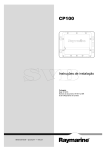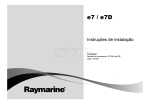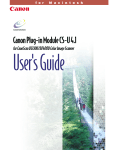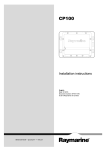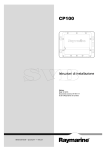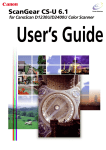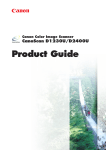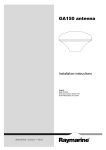Download Raymarine SeaTalk hs Specifications
Transcript
HS 5 Ins ta lla tion ins tructions En g lis h Da te : 08-2012 Docume nt numbe r: 87146-2-EN © 2012 Ra yma rine UK Limite d Trademark and patents notice Autohelm, hsb2, RayTech Navigator, Sail Pilot, SeaTalk, SeaTalkNG, SeaTalkHS and Sportpilot are registered trademarks of Raymarine UK Limited. RayTalk, Seahawk, Smartpilot, Pathfinder and Raymarine are registered trademarks of Raymarine Holdings Limited. FLIR is a registered trademark of FLIR Systems, Inc. and/or its subsidiaries. All other trademarks, trade names, or company names referenced herein are used for identification only and are the property of their respective owners. This product is protected by patents, design patents, patents pending, or design patents pending. Fair Use Statement You may print no more than three copies of this manual for your own use. You may not make any further copies or distribute or use the manual in any other way including without limitation exploiting the manual commercially or giving or selling copies to third parties. Product handbooks The latest versions of all English and translated handbooks are available to download in PDF format from the website www.raymarine.com. Please check the website to ensure you have the latest handbooks. Copyright ©2012 Raymarine UK Ltd. All rights reserved. ENGLISH Document number: 87146-2 Date: 08-2012 Contents Chapter 1 Introduction ............................................. 7 Handbook information ..................................................... 7 Product overview ............................................................ 7 Safety notices................................................................. 7 Important information ...................................................... 7 Chapter 2 Planning the installation ........................ 9 2.1 Installation checklist .................................................. 10 2.2 Parts supplied........................................................... 10 2.3 SeaTalkhs .................................................................. 11 2.4 Typical systems ........................................................ 11 2.5 Multiple switches....................................................... 12 Chapter 3 Cables and connections......................... 13 3.1 General cabling guidance .......................................... 14 3.2 Connections overview ............................................... 14 3.3 Network hardware ..................................................... 15 3.4 RayNet connector network cables .............................. 15 3.5 Network cable connector types .................................. 16 3.6 Equipment connection ............................................... 16 3.7 Power connection ..................................................... 17 Chapter 4 Installation ............................................... 19 4.1 Location requirements ............................................... 20 4.2 Mounting the unit ...................................................... 20 Chapter 5 Troubleshooting and support ................ 21 5.1 LED locations ........................................................... 22 5.2 LED indications......................................................... 23 5.3 Network switch troubleshooting.................................. 24 5.4 Raymarine customer support ..................................... 25 Appendix A Technical specification ....................... 27 5 6 HS5 Chapter 1: Introduction Caution: Service and maintenance Handbook information This product contains no user serviceable components. Please refer all maintenance and repair to authorized Raymarine dealers. Unauthorized repair may affect your warranty. This handbook describes how to install the Raymarine HS5 network switch as part of a marine electronics installation. This handbook includes information to help you: Water ingress • plan your installation; Water ingress disclaimer • install and connect the product as a part of your system of Raymarine electronics; Although the waterproof rating capacity of this product meets the IPX6 standard, water intrusion and subsequent equipment failure may occur if the product is subjected to commercial high-pressure washing. Raymarine will not warrant products subjected to high-pressure washing. • conduct checks to ensure that the product has been installed correctly; • obtain support if required. This and other Raymarine product documentation is available to download in PDF format from www.raymarine.com. Product overview A Raymarine network switch enables you to connect multiple SeaTalkhs devices to a Raymarine multifunction display. IMO and SOLAS The equipment described within this document is intended for use on leisure marine boats and workboats not covered by International Maritime Organization (IMO) and Safety of Life at Sea (SOLAS) Carriage Regulations. Product disposal Dispose of this product in accordance with the WEEE Directive. Raymarine networks typically consist of at least 2 of the following SeaTalkhs devices: • Radar scanner. • Digital Sounder Module (DSM). • Thermal camera. • Additional multifunction display. The Waste Electrical and Electronic Equipment (WEEE) Directive requires the recycling of waste electrical and electronic equipment. Whilst the WEEE Directive does not apply to some Raymarine products, we support its policy and ask you to be aware of how to dispose of this product. Technical accuracy Safety notices This product must be installed and operated in accordance with the instructions provided. Failure to do so could result in personal injury, damage to your vessel and/or poor product performance. To the best of our knowledge, the information in this document was correct at the time it was produced. However, Raymarine cannot accept liability for any inaccuracies or omissions it may contain. In addition, our policy of continuous product improvement may change specifications without notice. As a result, Raymarine cannot accept liability for any differences between the product and this document. Please check the Raymarine website (www.raymarine.com) to ensure you have the most up-to-date version(s) of the documentation for your product. Warning: Switch off power supply EMC installation guidelines Ensure the vessel’s power supply is switched OFF before starting to install this product. Do NOT connect or disconnect equipment with the power switched on, unless instructed in this document. Raymarine equipment and accessories conform to the appropriate Electromagnetic Compatibility (EMC) regulations, to minimize electromagnetic interference between equipment and minimize the effect such interference could have on the performance of your system Warning: Potential ignition source Correct installation is required to ensure that EMC performance is not compromised. Warning: Product installation and operation This product is NOT approved for use in hazardous/flammable atmospheres. Do NOT install in a hazardous/flammable atmosphere (such as in an engine room or near fuel tanks). Warning: Product grounding Before applying power to this product, ensure it has been correctly grounded, in accordance with the instructions in this guide. Important information Caution: Power supply protection When installing this product ensure the power source is adequately protected by means of a suitably-rated fuse or automatic circuit breaker. Introduction For optimum EMC performance we recommend that wherever possible: • Raymarine equipment and cables connected to it are: – At least 1 m (3 ft) from any equipment transmitting or cables carrying radio signals e.g. VHF radios, cables and antennas. In the case of SSB radios, the distance should be increased to 7 ft (2 m). – More than 2 m (7 ft) from the path of a radar beam. A radar beam can normally be assumed to spread 20 degrees above and below the radiating element. • The product is supplied from a separate battery from that used for engine start. This is important to prevent erratic behavior and data loss which can occur if the engine start does not have a separate battery. • Raymarine specified cables are used. • Cables are not cut or extended, unless doing so is detailed in the installation manual. 7 Note: Where constraints on the installation prevent any of the above recommendations, always ensure the maximum possible separation between different items of electrical equipment, to provide the best conditions for EMC performance throughout the installation Suppression ferrites Raymarine cables may be fitted with suppression ferrites. These are important for correct EMC performance. If a ferrite has to be removed for any purpose (e.g. installation or maintenance), it must be replaced in the original position before the product is used. Use only ferrites of the correct type, supplied by Raymarine authorized dealers. Connections to other equipment Requirement for ferrites on non-Raymarine cables If your Raymarine equipment is to be connected to other equipment using a cable not supplied by Raymarine, a suppression ferrite MUST always be attached to the cable near the Raymarine unit. Declaration of conformity Raymarine UK Ltd. declares that this product is compliant with the essential requirements of EMC directive 2004/108/EC. The original Declaration of Conformity certificate may be viewed on the relevant product page at www.raymarine.com. Warranty registration To register your Raymarine product ownership, please visit www.raymarine.com and register online. It is important that you register your product to receive full warranty benefits. Your unit package includes a bar code label indicating the serial number of the unit. You will need this serial number when registering your product online. You should retain the label for future reference. 8 HS5 Chapter 2: Planning the installation Chapter contents • 2.1 Installation checklist on page 10 • 2.2 Parts supplied on page 10 • 2.3 SeaTalkhs on page 11 • 2.4 Typical systems on page 11 • 2.5 Multiple switches on page 12 Planning the installation 9 2.1 Installation checklist 2.2 Parts supplied Installation includes the following activities: Installation Task 1 Plan your system. 2 Obtain all required equipment and tools. 3 Site all equipment. 4 Route all cables. 5 Drill cable and mounting holes. 6 Make all connections into equipment. 7 Secure all equipment in place. 8 Power on and test the system. 1 2 3 4 D12312-1 Schematic diagram 1. Network switch. A schematic diagram is an essential part of planning any installation. It is also useful for any future additions or maintenance of the system. The diagram should include: 2. Fixing screws. • Location of all components. 4. Documentation pack, consisting of: • Connectors, cable types, routes and lengths. 3. Power cable (red and black). • Installation instructions. • Mounting template. • Warranty policy. 10 HS5 2.3 SeaTalkhs 2.4 Typical systems SeaTalkhs is an ethernet based marine network. This high speed protocol allows compatible equipment to communicate rapidly and share large amounts of data. Example: Basic system 1 2 Information shared using the SeaTalkhs network includes: • Shared cartography (between compatible displays). • Digital radar data. • Sonar data. 4 SeaTalkhs / RayNet 3 SeaTalkhs / RayNet D12321-2 1. Network switch. 2. Multifunction display. 3. Radar scanner. 4. Thermal camera. Example: Expanded system 3 3 SeaTalkhs / RayNet 7 8 4 SeaTalkhs / RayNet 6 2 SeaTalkhs / RayNet 2 5 1 D12582-1 1. Thermal camera. 2. Multifunction display. 3. Network switch. 4. Connection between 2 network switches (Port 5 must be used for 1000 Mbit/S operation). 5. Radar scanner. 6. Antenna for Sirius weather receiver. 7. Sirius weather receiver. 8. Digital Sounder Module (DSM). Planning the installation 11 2.5 Multiple switches Systems with more than 5 SeaTalkhs devices require more than one network switch. Network switches can be connected together (“daisy-chaining”) for this purpose. The network switch provides a dedicated high-speed (1000 Mbit/S) port for connecting switches together while still retaining full data bandwidth throughout the system. However, each switch only has one high-speed port (port 5), so you can only connect up to 2 switches using the high-speed (1000 Mbit/S) connection. Any additional network switches must be connected together using a standard speed (100 Mbit/S) port (ports 1 to 4). You should take this factor into account when planning your system. The maximum number of SeaTalkhs devices that can be connected in any single system is 25. The following diagram illustrates 2 network switches connected together using the high-speed (1000 Mbit/S) connection (port 5): D12322-1 12 HS5 Chapter 3: Cables and connections Chapter contents • 3.1 General cabling guidance on page 14 • 3.2 Connections overview on page 14 • 3.3 Network hardware on page 15 • 3.4 RayNet connector network cables on page 15 • 3.5 Network cable connector types on page 16 • 3.6 Equipment connection on page 16 • 3.7 Power connection on page 17 Cables and connections 13 3.1 General cabling guidance 3.2 Connections overview Cable types and length It is important to use cables of the appropriate type and length • Unless otherwise stated use only standard cables of the correct type, supplied by Raymarine. • Ensure that any non-Raymarine cables are of the correct quality and gauge. For example, longer power cable runs may require larger wire gauges to minimize voltage drop along the run. Routing cables Cables must be routed correctly, to maximize performance and prolong cable life. • Do NOT bend cables excessively. Wherever possible, ensure a minimum bend diameter of 200 mm (8 in) / minimum bend radius of 100 mm (4 in). 1 2 3 4 5 6 D12313-1 1. Power (12 V / 24 V). 2. Port 1 (10 or 100 Mbit/S). 200 mm (8 in) 3. Port 2 (10 or 100 Mbit/S). 4. Port 3 (10 or 100 Mbit/S). 100 mm (4 in) 5. Port 4 (10 or 100 Mbit/S). 6. Port 5 (10, 100, or 1000 Mbit/S). • Protect all cables from physical damage and exposure to heat. Use trunking or conduit where possible. Do NOT run cables through bilges or doorways, or close to moving or hot objects. Note: The protective caps should be fitted to any unused ports. • Secure cables in place using tie-wraps or lacing twine. Coil any extra cable and tie it out of the way. • Where a cable passes through an exposed bulkhead or deckhead, use a suitable watertight feed-through. • Do NOT run cables near to engines or fluorescent lights. Always route data cables as far away as possible from: • other equipment and cables, • high current carrying ac and dc power lines, • antennae. Strain relief Ensure adequate strain relief is provided. Protect connectors from strain and ensure they will not pull out under extreme sea conditions. Circuit isolation Appropriate circuit isolation is required for installations using both AC and DC current: • Always use isolating transformers or a separate power-inverter to run PC’s, processors, displays and other sensitive electronic instruments or devices. • Always use an isolating transformer with Weather FAX audio cables. • Always use an isolated power supply when using a 3rd party audio amplifier. • Always use an RS232/NMEA converter with optical isolation on the signal lines. • Always make sure that PC’s or other sensitive electronic devices have a dedicated power circuit. Cable shielding Ensure that all data cables are properly shielded that the cable shielding is intact (e.g. hasn’t been scraped off by being squeezed through a tight area). 14 HS5 3.3 Network hardware 3.4 RayNet connector network cables Item Part number Notes Cable Part number HS5 SeaTalkhs network switch A80007 5–port switch for network connection of multiple SeaTalkhs devices featuring RayNet connectors. Equipment with SeaTalkhs connectors can also be connected via suitable adaptor cables. 1 m (3.28 ft) RayNet to SeaTalkhs (RJ45) cable A62360 2 m (6.56 ft) RayNet to RayNet cable A62361 5 m (16.4 ft) RayNet to RayNet cable A80005 10 m (32.8 ft) RayNet to RayNet cable A62362 20 m (65.6 ft) RayNet to RayNet cable A80006 RayNet cable puller 5 pack R70014 SeaTalkhs network E55058 8–port switch for network connection of multiple SeaTalkhs devices. E55060 Enables direct connection of SeaTalkhs devices to smaller systems where a switch is not required. Also enables the connection of SeaTalkhs devices to an HS5 SeaTalkhs network switch (in conjunction with a RayNet to RJ45 cable). switch SeaTalkhs crossover coupler Cables and connections 15 3.5 Network cable connector types 3.6 Equipment connection There are 2 types of network cable connector — SeaTalkhs and RayNet. SeaTalkhs equipment is connected to the switch using RayNet cables or a combination of SeaTalkhs cable, SeaTalkhs crossover coupler, and RayNet to RJ45 cable. SeaTalkhs connector. RayNet connector. There are 2 typical scenarios when connecting SeaTalkhs equipment to the network switch: Required cabling for new network switch Scenario Existing cabling 1. Existing or new installation with Raymarine equipment that has a RayNet connector. RayNet or none. • RayNet to RayNet cable. 2. Existing installation with Raymarine equipment that has a SeaTalkhs connector. SeaTalkhs cables. • Existing SeaTalkhs cables. • SeaTalkhs crossover coupler. • RayNet to RJ45 cable. These scenarios are illustrated below: Connection scenario 1 — equipment with RayNet connector 1 2 3 D12326-1 1. SeaTalkhs equipment with RayNet connector. 2. RayNet to RayNet cable. 3. Network switch. 16 HS5 Connection scenario 2 — equipment with SeaTalkhs connector 3.7 Power connection The power for the network switch is provided directly by a 12 V or 24 V power source. The network switch is supplied with a power cable with bare stripped wires, suitable for direct connection to a 12 V or 24 V power supply: 1 2 1 2 3 3 4 4 5 D12314-1 1. Network switch. 2. Power cable, red and black (supplied). 5 3. Red cable (positive). D12324-1 1. SeaTalkhs equipment — for example, E-Series Widescreen display. 2. SeaTalkhs cable. 3. SeaTalkhs crossover coupler. 4. Network switch. 5. RayNet to RJ45 cable. 4. Screen wire. 5. Black cable (negative). Warning: Do NOT power this product from a SeaTalkng backbone To avoid possible damage to equipment, do NOT use a SeaTalkng backbone as the power source for this product. Warning: Do NOT connect a SeaTalkng backbone to a 24 V power supply. To avoid possible damage to equipment, do NOT use the supplied power cable to connect a SeaTalkng backbone to a 24 V power supply. Cables and connections 17 18 HS5 Chapter 4: Installation Chapter contents • 4.1 Location requirements on page 20 • 4.2 Mounting the unit on page 20 Installation 19 4.1 Location requirements 4.2 Mounting the unit When selecting a location for the unit it is important to consider a number of factors. Before mounting the unit, ensure that you have: • Do NOT install near sources of heat or vibration (for example, an engine). • Selected a suitable location with cable clearance below the unit. • Identified the cable connections and routing. • Install below decks in a dry area. 1 2 3 D12317-1 • Must be mounted on a vertical surface. Sides and top must be level. 1. Fix the supplied mounting template to the selected location, using masking or self-adhesive tape. 2. Drill 2 holes at the positions indicated on the template. 3. Position the unit and hold it in place. 4. Insert a supplied mounting screw into each of the mounting holes. Do NOT tighten at this stage. 5. Gently push the unit downwards until both screws lock into position in the top of the mounting holes. 6. Tighten the screws. 20 HS5 Chapter 5: Troubleshooting and support Chapter contents • 5.1 LED locations on page 22 • 5.2 LED indications on page 23 • 5.3 Network switch troubleshooting on page 24 • 5.4 Raymarine customer support on page 25 Troubleshooting and support 21 5.1 LED locations LEDs indicating the status of the switch are located across the top of the unit. 1 2 D12327-1 Item Description 1 Power status. 2 Port status (one LED corresponding to each port). 22 LED color (Red) (Green) HS5 5.2 LED indications The LEDs on the unit indicate status information for diagnostic purposes. Power LED LED activity (based on 1000 ms (1 second) cycle) LED state description Unit status description Off Red 1000 ms 0 ms Off No power. 0 ms 1000 ms Continuous red. Unit powered on. Port LED LED activity (based on 1000 ms (1 second) cycle) LED state description Unit status description Off Green 1000 ms 0 ms Off No network connection. 0 ms 1000 ms Continuous green. Network connection established, but no network activity detected. 500 ms 500 ms Blinking green. Network connection established; network activity detected. 0 ms 84 ms Blinking green (fast). Network connection established; 1000 Mbit/S network activity detected. 0 ms 170 ms Blinking green (medium). Network connection established; 100 Mbit/S network activity detected. 0 ms 340 ms Blinking green (slow). Network connection established; 10 Mbit/S network activity detected. Troubleshooting and support 23 5.3 Network switch troubleshooting Problems with the network switch and possible causes and solutions are described here. Problem Possible causes Possible solutions No LEDs lit. No power. Check power connection to unit. Red power LED is lit but no port green LEDs are lit. Faulty or no connection for that port. Check the cable connection for the port. Check any additional connections (such as SeaTalkhs crossover couplers). No network activity. • Check that the unit connected to the switch is powered on. • Check that unit connected to the switch is currently transferring data. This can be confirmed by performing an action on the multifunction display that will initiate data transfer for the relevant unit — for example, if suspect a problem with the port corresponding to a connected radar scanner, range in or out in the radar application to initiate data activity. Slow or poor performance. 24 Large system featuring more than one network switch. Network switches are connected together via a 100 Mbit/S port. Use the dedicated 1000 Mbit/S port (port 5) to connect network switches together. You can connect a maximum of 2 switches together using a 1000 Mbit/S connection. HS5 5.4 Raymarine customer support Raymarine provides a comprehensive customer support service. You can contact customer support through the Raymarine website, telephone and email. If you are unable to resolve a problem, please use any of these facilities to obtain additional help. Web support Please visit the customer support area of our website at: www.raymarine.com This contains Frequently Asked Questions, servicing information, e-mail access to the Raymarine Technical Support Department and details of worldwide Raymarine agents. Telephone and email support In the USA: • Tel: +1 603 324 7900 • Toll Free: +1 800 539 5539 • Email: [email protected] In the UK, Europe, the Middle East, or Far East: • Tel: +44 (0)13 2924 6777 • Email: [email protected] Product information If you need to request service, please have the following information to hand: • Product name. • Product identity. • Serial number. • Software application version. You can obtain this product information using the menus within your product. Troubleshooting and support 25 26 HS5 Appendix A Technical specification Nominal supply voltage 12 or 24 V dc Operating voltage range 9 to 32 V dc Power consumption (typical) • < 2.5 W • < 600 mA @ 12 V Environmental Installation environment • Operating temperature: -25 ºC to +55 ºC (-13 ºF to 131 ºF) • Storage temperature: -25 ºC to +70 ºC (-13 ºF to 158 ºF) • Relative humidity: max 93% • Waterproof to IPX6 Conformance • Europe: 2004/108/EC • Australia and New Zealand: C-Tick, Compliance Level 2 • China: CCS certification Supported connection protocols • SeaTalkhs Supported connection speeds • 10 Mbit/S • 100 Mbit/S • 1000 Mbit/S (Port 5 only) Technical specification 27 28 HS5 www.ra ym a rin e .c o m






























